2022年中考英语二轮复习非谓语动词总复习(32张PPT)
文档属性
| 名称 | 2022年中考英语二轮复习非谓语动词总复习(32张PPT) | 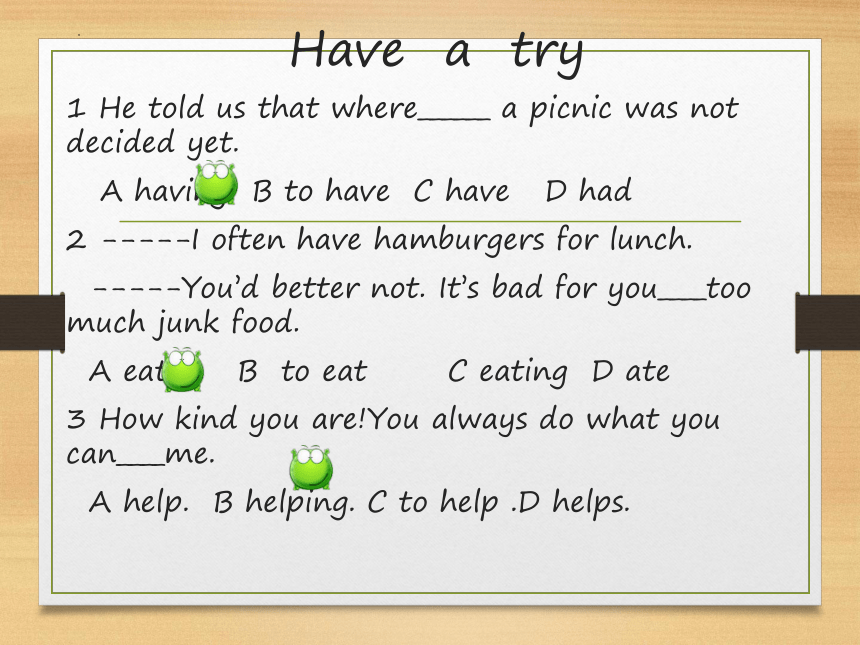 | |
| 格式 | ppt | ||
| 文件大小 | 2.3MB | ||
| 资源类型 | 教案 | ||
| 版本资源 | 人教新目标(Go for it)版 | ||
| 科目 | 英语 | ||
| 更新时间 | 2022-03-15 22:43:47 | ||
图片预览

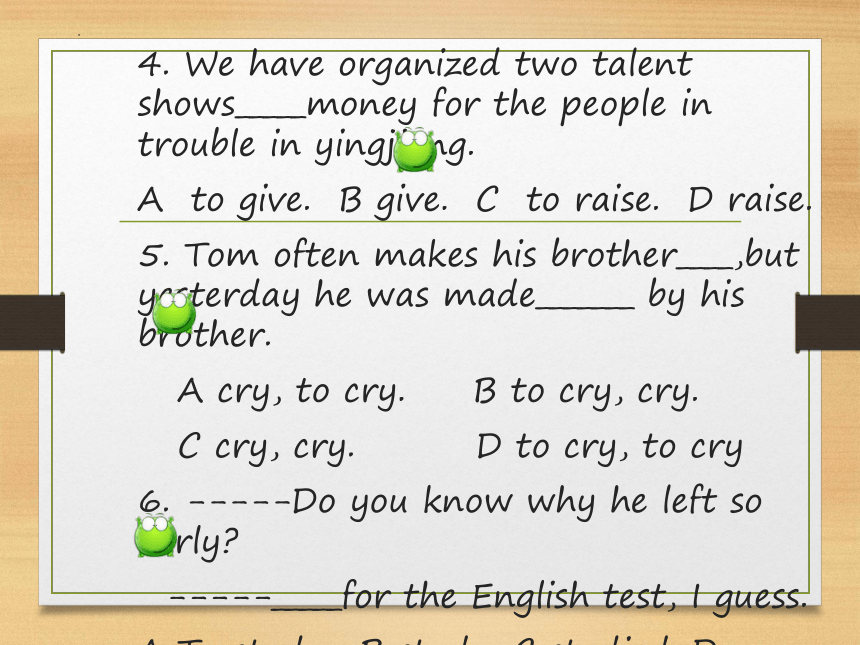


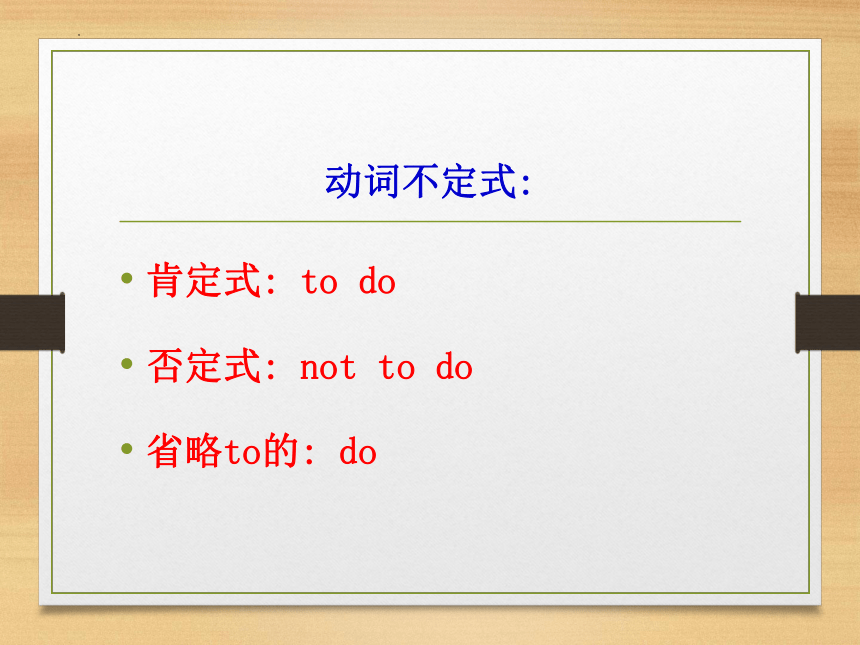
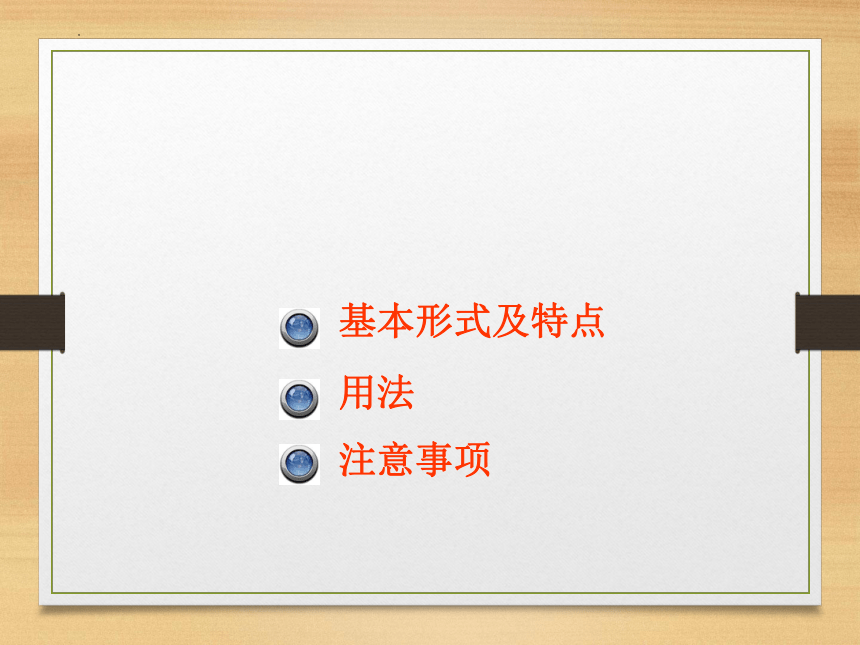
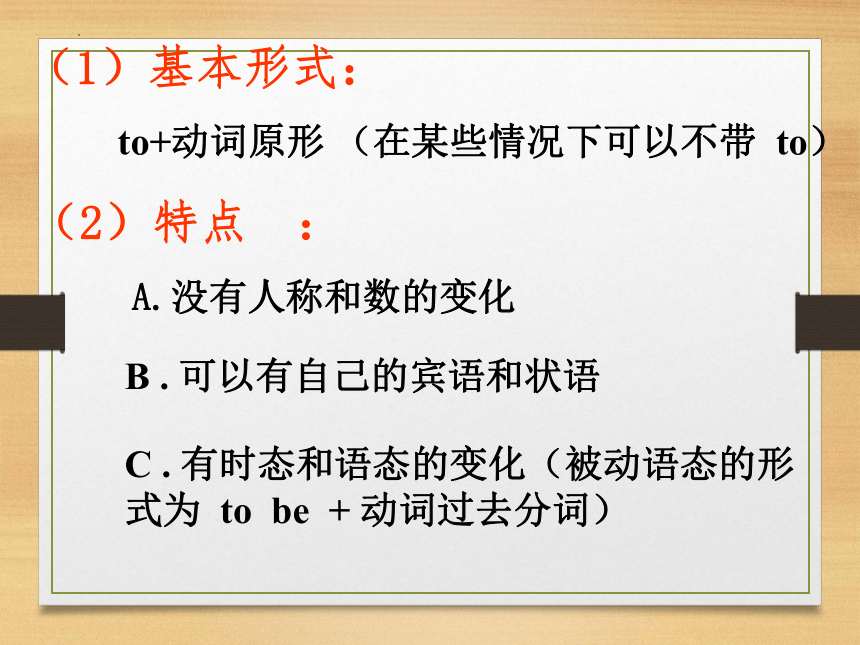

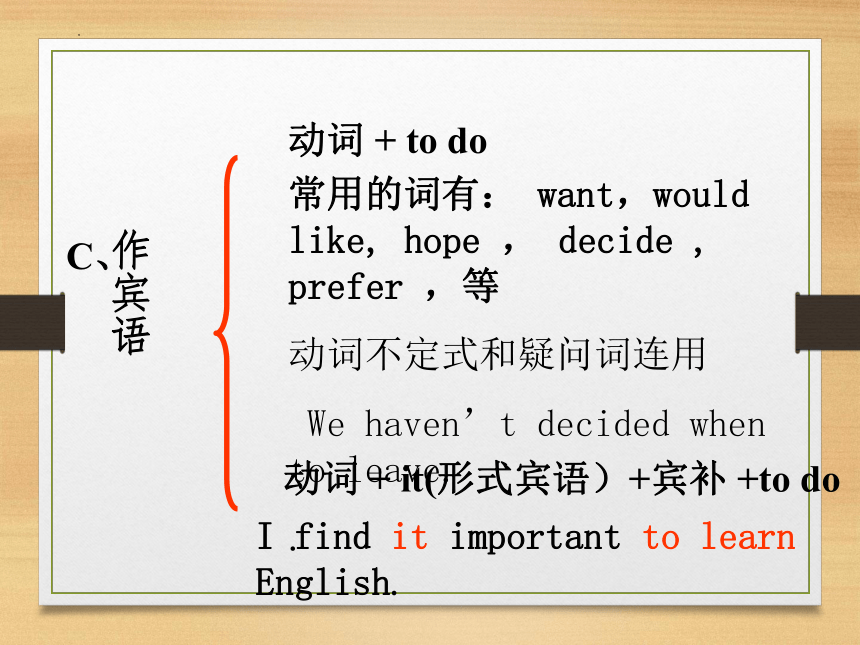
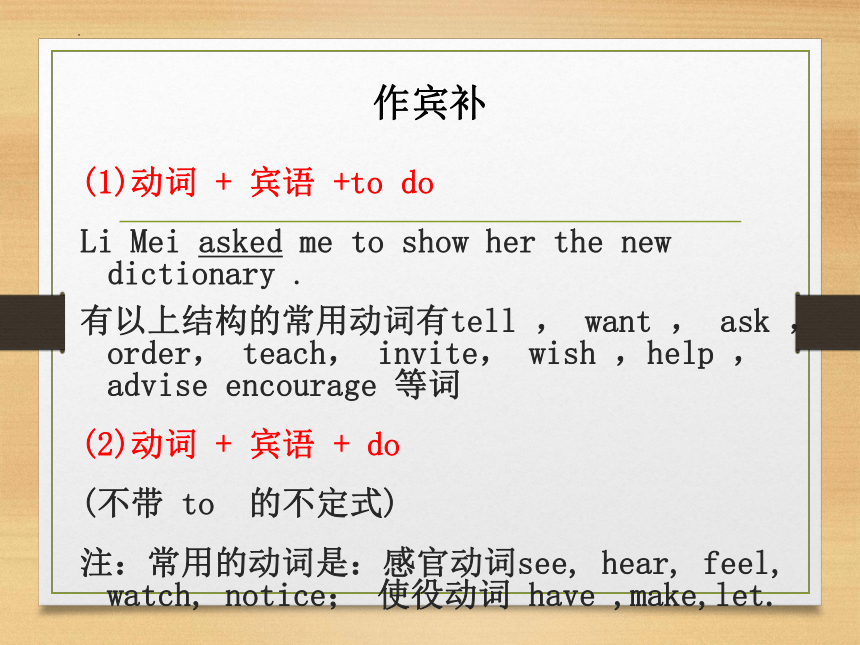

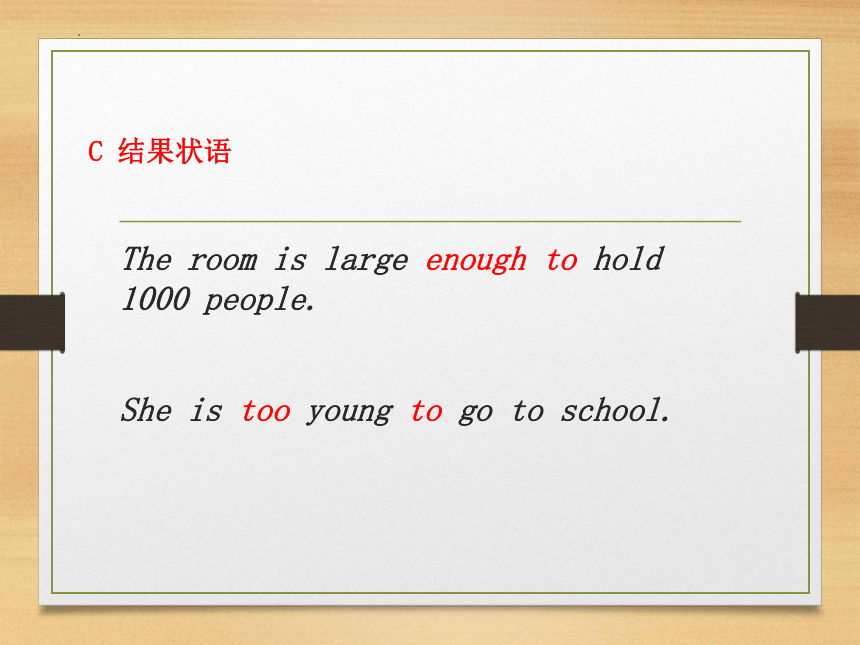
文档简介
(共32张PPT)
Have a try
1 He told us that where______ a picnic was not decided yet.
A having B to have C have D had
2 -----I often have hamburgers for lunch.
-----You’d better not. It’s bad for you____too much junk food.
A eat B to eat C eating D ate
3 How kind you are!You always do what you can____me.
A help. B helping. C to help .D helps.
4. We have organized two talent shows_____money for the people in trouble in yingjiang.
A to give. B give. C to raise. D raise.
5. Tom often makes his brother____,but yesterday he was made_______ by his brother.
A cry, to cry. B to cry, cry.
C cry, cry. D to cry, to cry
6. -----Do you know why he left so early
-----_____for the English test, I guess.
A To study. B study. C studied .D studying.
非谓语动词的概念
1、在句子中充当除谓语以外的句子成分的动词形式叫做非谓语动词。
2、它不受人称和数的限制
非谓语动词分为三种形式
不定式:to+动词原形
动名词:动词原形+ing
分词(过去分词)
动词不定式:
肯定式: to do
否定式: not to do
省略to的: do
基本形式及特点
用法
注意事项
(1)基本形式:
to+动词原形 (在某些情况下可以不带 to)
(2)特点 :
A.没有人称和数的变化
C . 有时态和语态的变化(被动语态的形式为 to be + 动词过去分词)
B . 可以有自己的宾语和状语
(3) 用法 :
A、作主语,如
To learn a foreign language is not easy . = It’s not easy to learn a foreign language.
注意:不定式短语作主语如果太长,常用it作形式主语,将不定式后置。除动词be外,常见的 动词有take也常用于上述结构
It took me two hours to clean my house yesterday.
B、作表语,如:
The important thing is to finish the work on time .
作宾语
C、
动词 + to do
动词 + it(形式宾语)+宾补 +to do
常用的词有: want,would like, hope , decide , prefer ,等
动词不定式和疑问词连用
We haven’t decided when to leave.
.
I find it important to learn English.
作宾补
(1)动词 + 宾语 +to do
Li Mei asked me to show her the new dictionary .
有以上结构的常用动词有tell , want , ask , order, teach, invite, wish ,help ,advise encourage 等词
(2)动词 + 宾语 + do
(不带 to 的不定式)
注:常用的动词是:感官动词see, hear, feel, watch, notice; 使役动词 have ,make,let.
作状语
A 目的状语
放在go , come , use , live, In order 等词的后面
例如: I come to visit you
He went home to ask for money.
He studies hard in order to have a good job in the future .
B 原因状语
放在sorry ,glad ,surprised ,excited 等词的后面
I’m glad to see you
I’m sorry to hear that .
C 结果状语
The room is large enough to hold 1000 people.
She is too young to go to school.
作定语
动词不定式做定语放在修饰的名词或代词之后
例如: He was the first student to go into the classroom.
I have something important to tell you.
I can do nothing to help you.
提示: 如果动词不定式和前面所修饰的词构成动宾关系,且动词是不及物动词,切记不要忘记后面的介词。
I have a small bedroom to live in
My parents have many animals to take care of .
省略to的情况:
使役动词和感官动词后:一感二听三让四看
feel/ hear, listen to/ let,make, have, /
look at, see, watch, notice
had better (not)do sth. 最好(不)做…
why not /why don’t you do sth为什么不做…
help sb.(to)do sth
Would rather宁愿做…
would you please
情态动词+do
助动词+do
在学习动词不定式的时候还有两点要注意哦!
1、在感官动词和使役动词后作宾补时,不定式可省略to,但以上词变为被动语态时,要加上to, 如
I always saw her play violin .
He was made to work 12hours a day.
2、动词不定式的否定形式为:
not + to do
Mr.Smith asked the boy ___________(not play) this kind of game.
not to play
Please have him __________(not do) so much housework.
not do
Have a test
1. It’s time for us _______ (have) supper
2. He is old enough (join) the army.
3. It took us an hour (work) out the problem.
4 .Would you like (go) shopping with me .
5. They prefer (stay) at home rather than go out.
6. I’m very glad (meet) you here .
7. I feel strange (have) a twin sister.
8. I saw them (come) into the room just now.
to have
to join
to work
to go
to stay
to meet
to have
come
9.What he said made me (feel )sorry .
10Have you got anything ( say )
11.Have you decided which one ( choose )
12.He is too weak (carry) the big box.
13.His plan is (spend )a few days in the mountains.
14. Do you know when (leave)
15.I’m sorry ,I forgot (tell) you the news .
to choose
feel
to say
to carry
to spend
to leave
to tell
Granny often tells us —— water in our daily life
A. save B. saving C. to save D. saves
17 If prices rise too high, the government has to do something———it.
A stop B stopped C stopping D to stop
18 -- Why are you so excited
-- Peter invited me ————on a trip to Yuntai Mountain.
A. to go B. go C. going D. went
C
C
D
A
19 The boss made the workers ______12hours a day .
A. works B. to work C. work D. working
20 My grandparents have a lot of animals. _______
A. to take care of B. take care C. to take care D. to taking care of
21 I saw him ______ his coat and ran out.
A. putting on B. put on C. to put on D. puts on
22 The young man used to ________ to work ,but he is used to ______to work now.
A. drive, walking B. drove, walked
C. drive, walks D. driving , walk
C
A
B
A
动名词由“动词原形+ ing”构成,其与现在分词同形。动名词既有动词的性质,也有名词的性质。在句中可作主语、宾语、表语和定语。
一、作主语
1.动名词直接作主语(单个动作作主语谓语动词用单数,两个和多个动名词作主语其后谓语用复数)
Playing computer games too much /is bad for your eyes.过度地玩电脑游戏对你的眼睛有害。
Listening to English songs and watching English films/ are good ways to learn English.
考点二 动名词
2.动名词作主语时,有时可以用it做形式主语。
It is useless/ no good/ no use后习惯用动名词。
如,
It’s no use saying so much. 说这么多也没有用。
It’s no good _______(live) in this way.
注意:动名词作主语和动词不定式作主语,在很多情况下可以通用。但,动名词作主语多之一般的,抽象的或多次的行为,动词不定式作主语往往表示一次性具体的动作。
living
二、作宾语
常接动名词作宾语的单词或短语有:
动词:
enjoy, finish, consider (考虑做), miss, keep, mind(介意做), practise, suggest, avoid(避免做),imagine想象
短语:
be busy(忙于做), can’t help(情不自禁做), can’t stop(停不下做) , have fun (做某事获得快乐)
介词后加Ving:
be used to(习惯于做), be worth(做某事值得) , be afraid of(害怕做), be proud of(做某事感到骄傲), be interested in(对做某事感兴趣), keep (stop) sb from doing (阻止某人做某事), look forward to(期盼做), put off(推迟做), feel like(想要做), give up(放弃做) 等。
注意:有些词既可接不定式又可接v. ing形式作宾语,但表达的意义不同。常见的有:
(1)stop to do sth停下来去做另外一件事(不定式作目的状语)
stop doing sth停止做某事(v. ing作宾语)
(2)try to do sth 尽力(企图)做某事
try doing sth尝试着做某事
(3)forget to do sth忘记要去做某事(还没做)
forget doing sth忘记做过了某事(已做)
(4)remember to do sth记着要去做某事(还没做)
remember doing sth记得做过了某事(已做)
(5)go on to do sth做完一件事后继续做另外一件不同的事
go on doing sth继续做原来所做的同一件事
(6)need doing(某事)需要做(被动含义)
need to do 需要去做某事(主动含义)
动名词作宾的特点是正在做某事;不定式作宾是要
去做某事,强调的是即将发生。
动名词综合练习
I feel like _______ (have) a walk along the river.
He has trouble_______(solve) the problem. Let’s help him.
Thank you very much for ____________(help) us.
The doctor was busy ___________(operate) on the boy at that time.
They couldn’t help ________(cry) after they heard the funny story.
My mother is used to _______(wear) a hat in winter.
having
solving
helping
operating
crying
wearing
Would you mind __________(not smoke) because there’re so many children ________(play) here
________(read) English is much easier than speaking it.
Her hobby is __________(collect) model planes.
You’d better (take)an umbrella with you.
Although they are tired, they still go on (work).
—Don’t forget (see) my parents when you are in Beijing.
Kate spent 30 minutes _______(clean) his bike.
not smoking
playing
Reading
collecting
take
working
to see
cleaning
分词分为 现在分词(v. ing) 和 过去分词(v. ed) 两种。有被动、完成之意。分词在句中可作定语、状语、表语和补语。
现在分词和过去分词的用法区别
1. 现在分词(v. ing) 表主动、进行之意在句中可作定语、状语、表语和补语。
The crying boy can’t find her mother.(定语,表进行)
那个正在哭的女孩找不到妈妈了。
(2)What about the photo of my cousin flying kites with Chinese kids in the Summer Palace. (定语,表进行)
(3) I saw her going upstairs.我看见她正在上楼。(宾补,表进行)
(4) Hearing the bad news, they couldn’t help crying.(状语,表主动)
考点三 分词
2.过去分词(v. ed) 表被动、完成之意,句中可作定语、状语、
表语和补语。
(1)I know the boy called Li Ming. .(作定语,表被动)
我认识那个叫李明的男孩。
(2) She found the novel written by Mark Twain. (宾补,表被动)
她发现这本小说是马克吐温写的。
(3)My chocolate cookies are done now.(作表语,表完成)
(4) Broken by Jim, I can’t use the cup. (作状语,表被动)
杯子被Jim打破了,我不能用了。
3.其它区别:现在分词表示事物本书所具有的性质,意为“令人……”,过去分词表示由外界引起的内心活动,意为“感到……”
the exciting news 令人激动的消息
the excited look 激动的表情
surprising令人惊讶的
Surprised感到惊讶的
1.China is a __________(develop) country. America is a _________(develop) country.
中国是一个发展中国家,美国是一个发达国家
2. I often hear her ________(sing) this song in the classroom after class.
Listen!I hear someone_________(sing) in the classroom.
3. Please stop ________(have) a rest if you feel tired.
4.It’s a pity that I forgot to take my _________(swim) clothes.
5. Jack took an interest in _______(play) ping-pong soon after he came to China.
developing
developed
sing
singing
to have
swimming
playing
6. Seeing their teacher _________(enter) into the classroom, they stopped ________(talk) at once.
7.When I was walking past the window, I noticed Wang Fei________(copy) my homework. I really got_______(amaze).
8. Some photos ________(take)by the children of Yushu, Qinghai are on show now.
9. ________(hear) the good news, he jumped with joy.
10. When I went into the room,I found him________(lie) in bed.
entering
talking
copying
amazed
Hearing
taken
lying
非谓语动词
动名词Ving
分词
现在分词Ving
过去分词
动词不定式 to do
主语
It作形式主语时的3个常用句型结构
宾语
主语+_____(动词)+to do sth.
宾补
主语+_____(动词)+sb.+(not) to do
sth. 省略to的情况
状语
目的状语
定语
后置定语
to do 不定式表示动作
即将发生
主语
It作形式主语时的常用句型结构;
谓语单复数
宾语
常接动名词作宾语的单词或短语
表主动、进行之意
表被动、完成之意
分词在句中可作定语、
状语、表语和补语。
Ving强调动作
正在进行
既可以跟不定式
作宾语也可以跟
动名词作宾语的动
词,及其不同意义
Thanks!
Have a try
1 He told us that where______ a picnic was not decided yet.
A having B to have C have D had
2 -----I often have hamburgers for lunch.
-----You’d better not. It’s bad for you____too much junk food.
A eat B to eat C eating D ate
3 How kind you are!You always do what you can____me.
A help. B helping. C to help .D helps.
4. We have organized two talent shows_____money for the people in trouble in yingjiang.
A to give. B give. C to raise. D raise.
5. Tom often makes his brother____,but yesterday he was made_______ by his brother.
A cry, to cry. B to cry, cry.
C cry, cry. D to cry, to cry
6. -----Do you know why he left so early
-----_____for the English test, I guess.
A To study. B study. C studied .D studying.
非谓语动词的概念
1、在句子中充当除谓语以外的句子成分的动词形式叫做非谓语动词。
2、它不受人称和数的限制
非谓语动词分为三种形式
不定式:to+动词原形
动名词:动词原形+ing
分词(过去分词)
动词不定式:
肯定式: to do
否定式: not to do
省略to的: do
基本形式及特点
用法
注意事项
(1)基本形式:
to+动词原形 (在某些情况下可以不带 to)
(2)特点 :
A.没有人称和数的变化
C . 有时态和语态的变化(被动语态的形式为 to be + 动词过去分词)
B . 可以有自己的宾语和状语
(3) 用法 :
A、作主语,如
To learn a foreign language is not easy . = It’s not easy to learn a foreign language.
注意:不定式短语作主语如果太长,常用it作形式主语,将不定式后置。除动词be外,常见的 动词有take也常用于上述结构
It took me two hours to clean my house yesterday.
B、作表语,如:
The important thing is to finish the work on time .
作宾语
C、
动词 + to do
动词 + it(形式宾语)+宾补 +to do
常用的词有: want,would like, hope , decide , prefer ,等
动词不定式和疑问词连用
We haven’t decided when to leave.
.
I find it important to learn English.
作宾补
(1)动词 + 宾语 +to do
Li Mei asked me to show her the new dictionary .
有以上结构的常用动词有tell , want , ask , order, teach, invite, wish ,help ,advise encourage 等词
(2)动词 + 宾语 + do
(不带 to 的不定式)
注:常用的动词是:感官动词see, hear, feel, watch, notice; 使役动词 have ,make,let.
作状语
A 目的状语
放在go , come , use , live, In order 等词的后面
例如: I come to visit you
He went home to ask for money.
He studies hard in order to have a good job in the future .
B 原因状语
放在sorry ,glad ,surprised ,excited 等词的后面
I’m glad to see you
I’m sorry to hear that .
C 结果状语
The room is large enough to hold 1000 people.
She is too young to go to school.
作定语
动词不定式做定语放在修饰的名词或代词之后
例如: He was the first student to go into the classroom.
I have something important to tell you.
I can do nothing to help you.
提示: 如果动词不定式和前面所修饰的词构成动宾关系,且动词是不及物动词,切记不要忘记后面的介词。
I have a small bedroom to live in
My parents have many animals to take care of .
省略to的情况:
使役动词和感官动词后:一感二听三让四看
feel/ hear, listen to/ let,make, have, /
look at, see, watch, notice
had better (not)do sth. 最好(不)做…
why not /why don’t you do sth为什么不做…
help sb.(to)do sth
Would rather宁愿做…
would you please
情态动词+do
助动词+do
在学习动词不定式的时候还有两点要注意哦!
1、在感官动词和使役动词后作宾补时,不定式可省略to,但以上词变为被动语态时,要加上to, 如
I always saw her play violin .
He was made to work 12hours a day.
2、动词不定式的否定形式为:
not + to do
Mr.Smith asked the boy ___________(not play) this kind of game.
not to play
Please have him __________(not do) so much housework.
not do
Have a test
1. It’s time for us _______ (have) supper
2. He is old enough (join) the army.
3. It took us an hour (work) out the problem.
4 .Would you like (go) shopping with me .
5. They prefer (stay) at home rather than go out.
6. I’m very glad (meet) you here .
7. I feel strange (have) a twin sister.
8. I saw them (come) into the room just now.
to have
to join
to work
to go
to stay
to meet
to have
come
9.What he said made me (feel )sorry .
10Have you got anything ( say )
11.Have you decided which one ( choose )
12.He is too weak (carry) the big box.
13.His plan is (spend )a few days in the mountains.
14. Do you know when (leave)
15.I’m sorry ,I forgot (tell) you the news .
to choose
feel
to say
to carry
to spend
to leave
to tell
Granny often tells us —— water in our daily life
A. save B. saving C. to save D. saves
17 If prices rise too high, the government has to do something———it.
A stop B stopped C stopping D to stop
18 -- Why are you so excited
-- Peter invited me ————on a trip to Yuntai Mountain.
A. to go B. go C. going D. went
C
C
D
A
19 The boss made the workers ______12hours a day .
A. works B. to work C. work D. working
20 My grandparents have a lot of animals. _______
A. to take care of B. take care C. to take care D. to taking care of
21 I saw him ______ his coat and ran out.
A. putting on B. put on C. to put on D. puts on
22 The young man used to ________ to work ,but he is used to ______to work now.
A. drive, walking B. drove, walked
C. drive, walks D. driving , walk
C
A
B
A
动名词由“动词原形+ ing”构成,其与现在分词同形。动名词既有动词的性质,也有名词的性质。在句中可作主语、宾语、表语和定语。
一、作主语
1.动名词直接作主语(单个动作作主语谓语动词用单数,两个和多个动名词作主语其后谓语用复数)
Playing computer games too much /is bad for your eyes.过度地玩电脑游戏对你的眼睛有害。
Listening to English songs and watching English films/ are good ways to learn English.
考点二 动名词
2.动名词作主语时,有时可以用it做形式主语。
It is useless/ no good/ no use后习惯用动名词。
如,
It’s no use saying so much. 说这么多也没有用。
It’s no good _______(live) in this way.
注意:动名词作主语和动词不定式作主语,在很多情况下可以通用。但,动名词作主语多之一般的,抽象的或多次的行为,动词不定式作主语往往表示一次性具体的动作。
living
二、作宾语
常接动名词作宾语的单词或短语有:
动词:
enjoy, finish, consider (考虑做), miss, keep, mind(介意做), practise, suggest, avoid(避免做),imagine想象
短语:
be busy(忙于做), can’t help(情不自禁做), can’t stop(停不下做) , have fun (做某事获得快乐)
介词后加Ving:
be used to(习惯于做), be worth(做某事值得) , be afraid of(害怕做), be proud of(做某事感到骄傲), be interested in(对做某事感兴趣), keep (stop) sb from doing (阻止某人做某事), look forward to(期盼做), put off(推迟做), feel like(想要做), give up(放弃做) 等。
注意:有些词既可接不定式又可接v. ing形式作宾语,但表达的意义不同。常见的有:
(1)stop to do sth停下来去做另外一件事(不定式作目的状语)
stop doing sth停止做某事(v. ing作宾语)
(2)try to do sth 尽力(企图)做某事
try doing sth尝试着做某事
(3)forget to do sth忘记要去做某事(还没做)
forget doing sth忘记做过了某事(已做)
(4)remember to do sth记着要去做某事(还没做)
remember doing sth记得做过了某事(已做)
(5)go on to do sth做完一件事后继续做另外一件不同的事
go on doing sth继续做原来所做的同一件事
(6)need doing(某事)需要做(被动含义)
need to do 需要去做某事(主动含义)
动名词作宾的特点是正在做某事;不定式作宾是要
去做某事,强调的是即将发生。
动名词综合练习
I feel like _______ (have) a walk along the river.
He has trouble_______(solve) the problem. Let’s help him.
Thank you very much for ____________(help) us.
The doctor was busy ___________(operate) on the boy at that time.
They couldn’t help ________(cry) after they heard the funny story.
My mother is used to _______(wear) a hat in winter.
having
solving
helping
operating
crying
wearing
Would you mind __________(not smoke) because there’re so many children ________(play) here
________(read) English is much easier than speaking it.
Her hobby is __________(collect) model planes.
You’d better (take)an umbrella with you.
Although they are tired, they still go on (work).
—Don’t forget (see) my parents when you are in Beijing.
Kate spent 30 minutes _______(clean) his bike.
not smoking
playing
Reading
collecting
take
working
to see
cleaning
分词分为 现在分词(v. ing) 和 过去分词(v. ed) 两种。有被动、完成之意。分词在句中可作定语、状语、表语和补语。
现在分词和过去分词的用法区别
1. 现在分词(v. ing) 表主动、进行之意在句中可作定语、状语、表语和补语。
The crying boy can’t find her mother.(定语,表进行)
那个正在哭的女孩找不到妈妈了。
(2)What about the photo of my cousin flying kites with Chinese kids in the Summer Palace. (定语,表进行)
(3) I saw her going upstairs.我看见她正在上楼。(宾补,表进行)
(4) Hearing the bad news, they couldn’t help crying.(状语,表主动)
考点三 分词
2.过去分词(v. ed) 表被动、完成之意,句中可作定语、状语、
表语和补语。
(1)I know the boy called Li Ming. .(作定语,表被动)
我认识那个叫李明的男孩。
(2) She found the novel written by Mark Twain. (宾补,表被动)
她发现这本小说是马克吐温写的。
(3)My chocolate cookies are done now.(作表语,表完成)
(4) Broken by Jim, I can’t use the cup. (作状语,表被动)
杯子被Jim打破了,我不能用了。
3.其它区别:现在分词表示事物本书所具有的性质,意为“令人……”,过去分词表示由外界引起的内心活动,意为“感到……”
the exciting news 令人激动的消息
the excited look 激动的表情
surprising令人惊讶的
Surprised感到惊讶的
1.China is a __________(develop) country. America is a _________(develop) country.
中国是一个发展中国家,美国是一个发达国家
2. I often hear her ________(sing) this song in the classroom after class.
Listen!I hear someone_________(sing) in the classroom.
3. Please stop ________(have) a rest if you feel tired.
4.It’s a pity that I forgot to take my _________(swim) clothes.
5. Jack took an interest in _______(play) ping-pong soon after he came to China.
developing
developed
sing
singing
to have
swimming
playing
6. Seeing their teacher _________(enter) into the classroom, they stopped ________(talk) at once.
7.When I was walking past the window, I noticed Wang Fei________(copy) my homework. I really got_______(amaze).
8. Some photos ________(take)by the children of Yushu, Qinghai are on show now.
9. ________(hear) the good news, he jumped with joy.
10. When I went into the room,I found him________(lie) in bed.
entering
talking
copying
amazed
Hearing
taken
lying
非谓语动词
动名词Ving
分词
现在分词Ving
过去分词
动词不定式 to do
主语
It作形式主语时的3个常用句型结构
宾语
主语+_____(动词)+to do sth.
宾补
主语+_____(动词)+sb.+(not) to do
sth. 省略to的情况
状语
目的状语
定语
后置定语
to do 不定式表示动作
即将发生
主语
It作形式主语时的常用句型结构;
谓语单复数
宾语
常接动名词作宾语的单词或短语
表主动、进行之意
表被动、完成之意
分词在句中可作定语、
状语、表语和补语。
Ving强调动作
正在进行
既可以跟不定式
作宾语也可以跟
动名词作宾语的动
词,及其不同意义
Thanks!
同课章节目录
- 词法
- 名词
- 动词和动词短语
- 动词语态
- 动词时态
- 助动词和情态动词
- 非谓语动词
- 冠词
- 代词
- 数词和量词
- 形容词副词及其比较等级
- 介词和介词短语
- 连词和感叹词
- 构词法
- 相似、相近词比较
- 句法
- 陈述句
- 一般疑问句和否定疑问句
- 特殊疑问句及选择疑问句
- 反意疑问句
- 存在句(There be句型)
- 宾语从句
- 定语从句
- 状语从句
- 主谓一致问题
- 简单句
- 并列句
- 复合句
- 主谓一致
- 主、表语从句
- 名词性从句
- 直接引语和间接引语
- 虚拟语气
- 感叹句
- 强调句
- 倒装句
- 祈使句
- 句子的成分
- 句子的分类
- 题型专区
- 单项选择部分
- 易错题
- 完形填空
- 阅读理解
- 词汇练习
- 听说训练
- 句型转换
- 补全对话
- 短文改错
- 翻译
- 书面表达
- 任务型阅读
- 语法填空
- 其他资料
